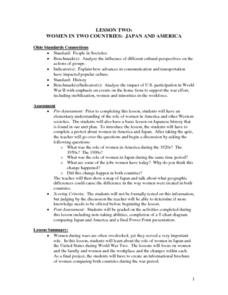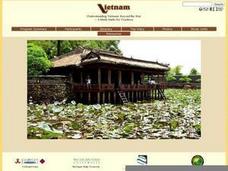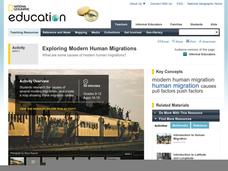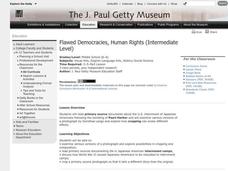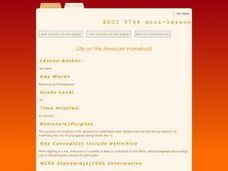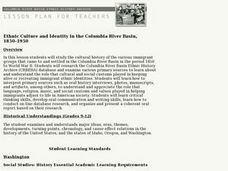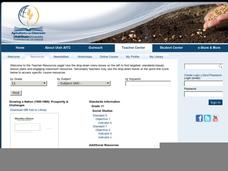Curated OER
The Ethics of the Bomb: What Would You Do?
Learners research the use of the atomic bomb in WWII, analyze the human costs of dropping the bomb and identify the pros and cons. They develop a PowerPoint presentation on the effects of an atomic bomb dropped on their hometown.
Curated OER
Baby Boom and the Culture of the 1950's
Eleventh graders explain the causes, course, and consequences of the United States' role in World War II.
Curated OER
Women in Two Countries: Japan and America
Students explore the role of women in Japan and the United States during World War Two. They focus on women and the family and women and the workplace and the changes within each. Students create an informational brochure of women...
Curated OER
Language Arts: Novel Guides
Students discuss the Revolution and consider the causes of the war, the attitudes of the colonists, and the position of the British. Then students explore American involvement in wars since the country's inception.
Curated OER
A Brief History of Vietnam (1858-2004) and Its Evolving Communist System
High schoolers examine the French colonization of Vietnam, the Vietnam War, and the current evolving Communist system. They develop political maps, outline the major events of the Vietnam War, write an essay, and compare/contrast...
National Geographic
Exploring Modern Human Migrations
Using maps, images, websites, and handouts, learners work to understand the nature of human migrations. They compare and contrast human migration from the past to the present, identify causes for migration, and trace migration routes on...
Curated OER
Sadako and the Thousand Paper Cranes
Have your class explore the effects of war by reading Eleanor Coerr's story, "Sadako and the Thousand Paper Cranes." This is a story about a sixth grader who lives in Hiroshima when the atomic bomb is dropped. Learners answer questions,...
Curated OER
The Westward Movement
Students study the westward movement through examining stamps. For this westward movement lesson plan, students draw conclusions, determine cause and effect relationships and examine the westward movement of the United States by...
Curated OER
America and the Sino-Japanese Conflict, 1933-1939
Students examine the U.S. stance regarding the Sino-Japanese conflict. In this diplomacy lesson plan, students analyze the sanctions employed by United States on Japan when they took over Manchuria. Students determine how...
Albert Shanker Institute
Economic Causes of the March on Washington
Money can't buy happiness, but it can put food on the table and pay the bills. The first of a five-lesson unit teaches pupils about the unemployment rate in 1963 and its relationship with the March on Washington. They learn how to create...
Curated OER
Checks and Balances: Japanese-American Incarceration
Students examine the three branches of the Federal Government and their decision to place Japanese-Americans in camps during World War II. They analyze debates made by leaders during this time period.
National First Ladies' Library
World Starvation
Students investigate the concept of world starvation and some of the organizations that are founded in order to help solve the problem. They conduct research using a variety of resources. The information is used in order to conduct class...
Curated OER
Flawed Democracies, Human Rights
Students investigate the bombing of Pearl Harbor. In this U.S. History lesson, students discover the Japanese internment camps and why our government chose to relocate the Japanese. Students examine photographs from the era...
Curated OER
Houghton Mifflin Social Studies/Chapter 11, Lesson 1: California in Wartime (pp. 250-253)
Fourth graders explore the crisis of Japanese Americans during World War II. The benefits of the California economy are explored. The lesson plan has a discussion portion that is culturally relevant for many types of students.
Curated OER
Hiroshima, From All Sides
Students comprehend how the Atomic Bomb affected humanity and ended WWII. They comprehend how the Atomic Bomb affected: scientists, Japanese citizens, and US leaders. Students receive a copy of Hiroshima, Readers Theater Rubiv. They...
Curated OER
Jewish Ghettos and Death/Concentration Camps
Students trace and explain the antecedents, causes, major events, and global consequences of World War II, including the Holocaust. They assess the conditions of Jewish inhabitants of the Ghettos and death/concentration camps and the...
Curated OER
Life on the American Homefront
Seventh graders examine the conditions of the homefront during World War II. Using propaganda, they discuss its role and how it affected people who viewed it. They identify the role citizens played during the war and create their own...
Curated OER
Ethnic Culture and Identity in the Columbia River Basin, 1850-1950
Students explore cultural history of immigrant groups that settled in the Columbia River Basin from 1850 to World War II, and examine various primary sources to explore role cultural and social customs played in keeping alive immigrant...
Curated OER
Scapegoating
Students examine how stereotypes, prejudices and discriminatory practices lead to individuals and groups being blamed for events. They are introduced to the internment of Japanese Americans during World War II.
Curated OER
Korean War
Students visualize where the Korean Peninsula is located and what are some neighboring countries. They read a handout giving background information on Korea's 20th centuy history and Truman's Statement and answer questions in their...
Agriculture in the Classroom
Growing a Nation (1950-1969): Prosperity & Challenges: The Story of American Agriculture
A wonderful lesson on the development and impact of mechanized farming! History or agriculture classes learn the historical background of the United States' food production by creating a pamphlet with information on the cause and...
Smithsonian Institution
Cuban Missile Crisis
The United States—specifically John F. Kennedy—played a large role during the Cuban Missile Crisis. A history resource poses questions that encourage critical thinking as well as in-depth analysis of images from the time period.
Curated OER
Celebrate The Four Seasons
Students investigate cause and effect and compare and contrast how recurring cycles are evident in multiple aspects of their education. They answer questions in the chosen field. Students model each aspect by interpreting, perceiving and...
Curated OER
The Atomic Bomb
In this atomic bomb study guide worksheet, students read a brief overview pertaining to the topic and then respond to a reflection question.


